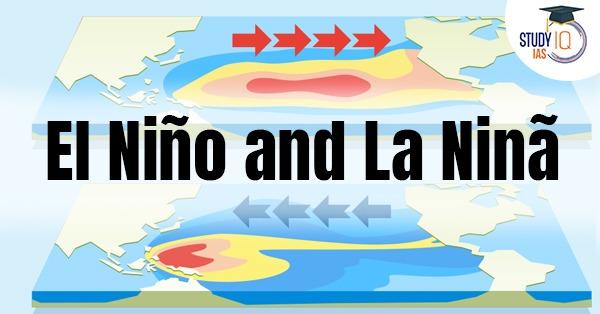Table of Contents
About El Niño and La Ninã (ENSO)
- There are only six instances of La Ninã lasting for more than two years since 1950s, data with the India Meteorological Department (IMD) show.
- The continuation of La Nina conditions spanning over 2 consecutive years is also called ‘Double Dip’ La Nina.


- The Forecasting agencies from different countries have confirmed that the La Ninã conditions are here to stay till the end of 2022.
- This year, India has received 3mm rainfall which was quantitatively 7 percent above the seasonal average till August 30. Out of the 36 states/Union Territories, 30 have received rainfall categorized as ‘normal’ or ‘excess’ or ‘large excess’, attributed to the La Ninã conditions.
- For India, this could mean longer monsoons, prolonged heatwaves, higher rate of cyclone formation in Bay of Bengal and increased chances of flooding.
El Niño–Southern Oscillation (ENSO)
- ENSO is an irregular periodic variation in winds and sea surface temperatures over the tropical eastern Pacific Ocean, affecting the climate of much of the tropics and subtropics.
- The warming phase of the sea temperature is known as El Niño and the cooling phase as La Niña.
- These deviations from normal surface temperatures can have large-scale impacts not only on ocean processes, but also on global weather and climate.

| Basics of Comparision | El Niño | La Niña |
| Meaning | El Niño means Little Boy or Christ Child in Spanish. | La Niña means Little Girl in Spanish. |
| Sea surface of temperature | It represents the above-average sea-surface temperatures that periodically develop across the east-central equatorial Pacific. | It represents the periodic cooling of sea-surface temperatures across the east-central equatorial Pacific. |
| Pressure | It is laden with high air surface pressure in the western Pacific. | It contains low air surface pressure in the eastern Pacific |
| Formation | During El Niño, trade winds weaken. Warm water is pushed back east, toward the west coast of the Americas, resulting in a weaker Walker cell. Cold Peruvian (Humboldt) current gets replaced by warm Elnino (cormwell) current. | During La Niña events, trade winds are even stronger than usual, pushing more warm water toward Asia, resulting in a stronger Walker cell. |
| Period of occurrence | Typically occurs every 3-5 years and lasts 9-12 months. | Typically occur every 3-5 years and lasts 1-3 years. |
| Impacts |
|
|
| Impact of Indian Monsoon | The monsoon is affected so heavily that 70% reduction of the rainfall is expected. The winds doesn’t carry the moisture towards Indian landmass dueing El Nino causing deficiency in rainfall. | La Nina causes high temperatures over the Indian Ocean, off the Somalian coast and a comparatively better monsoon rains in India. |






















 WhatsApp
WhatsApp